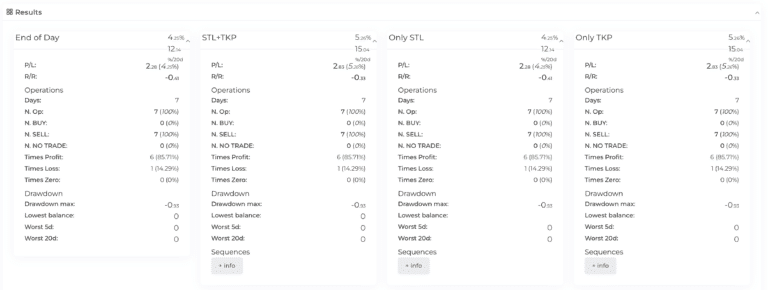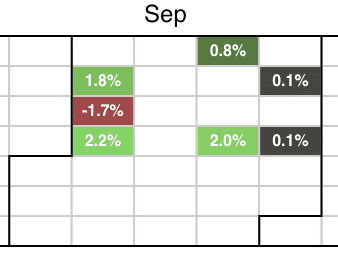In this context, those who enjoy repetitive operations, or even just those who are profit-oriented and thus approach trading systems for this reason, have only one concern: To find a trading system that has been profitable in the past and to size such a trading plan according to their own money management. Using MetricAlgo with its Metrix Suite product, it is possible to search among thousands of already calculated trading systems or even calculate your own with the powerful built-in analyzer filter. The challenge was to select a profitable trading system to trade in September 2023 that had at least 60% of historical trades winning, at least 8 profitable years out of 10, a moderate monthly drawdown, and finally, to apply the same operation every day of the month if conditions allow.
Since we need to find a profitable result of a trading system, it is much easier to search for it among these than to select a stock a priori and analyze which metrics work best on it to have a statistical advantage. The difference in approach is that if I am looking for a trading system for September and I start analyzing a specific stock, I could find profitable trades, but in periods that are not September. Additionally, this research would cost me time. Therefore, we will prepare our analysis in the following way:
Moreover, it should not be forgotten that the MetrixSuite tool is capable of generating systems, each tradable with 4 operational modes: Trades without Stop loss and Take Profit orders (we call them EOD because trades are closed at the end of the session), trades with Stop Loss only, Take Profit only, and obviously with both exit orders.
Every single system can also be further customized by adjusting the risk/reward ratio to one’s preference and then assessing the final result of the system itself. In this analysis, we will not customize the system and will trade it as it is provided by the platform.
The MetricAlgo tool to use in this case is Metrix Suite, within which you can access Metrix Cloud. This container contains all the trading systems that MetricAlgo has calculated over time and continues to calculate as it is used by users, artificial intelligence, and the staff itself. Once entered, we will be able to filter the systems using specific metrics, like so. For example, as shown in this image:
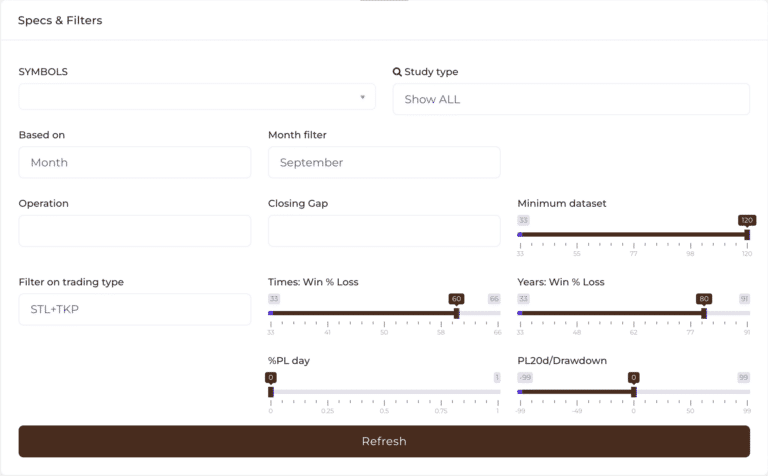
The result obtained from applying this search yielded a series of systems that have been calculated and can be applied in various ways. Some are based on tight stop losses and wide take profits. Others, conversely, have wide stop losses and tight take profits, while some operate without stop loss and take profit, anticipating closure at the end of the day. Each one has its own characteristics based on how they were generated by those who created and searched for them. Therefore, it’s important to analyze each one to then choose the best for our needs.
In this specific case, the companies returned are:
DOW – Dow Inc
KMI – Kinder Morgan Inc
MCHP – Microchip Technology Inc
HPQ – HP Inc
PG – Procter & Gamble Co
PEP – PepsiCo, Inc.
MDLZ – MONDELEZ INTERNATIONAL INC Common Stock
VZ – Verizon Communications Inc.
Since 8 companies have come up, but if I wanted to evaluate fewer, I would narrow the filter parameters by changing the % Daily P/L from ≥0% to ≥0.25%
Not before, however, quickly reviewing the results through the summary popup.
By doing this, we have obtained the following candidates to be traded in September.

Search parameters for this study:
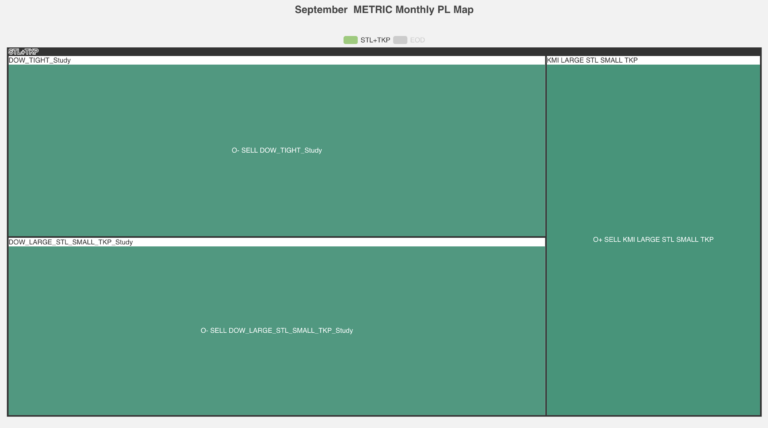
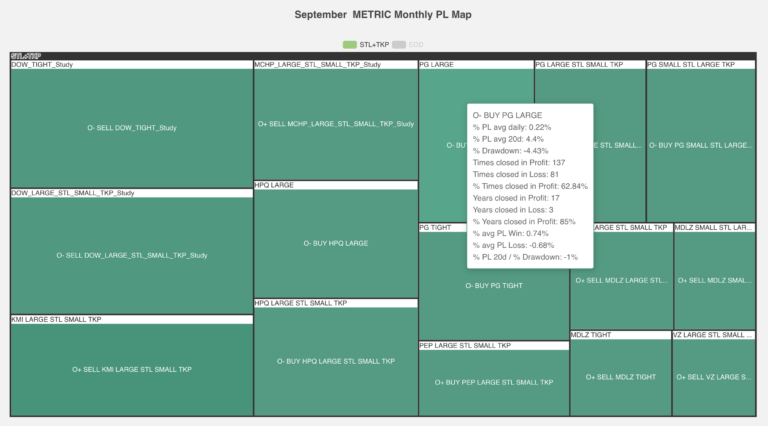
Once these three trading systems have been identified as the best of the month according to the requirements, all that remains is to start the selection of the system to trade and then begin the analysis of the three systems. The first thing that stands out is that the systems have two fundamentally different approaches. DOW shows good results both with tight exit orders (Tight) and with a wide Stop Loss and tight Take Profit, while Kinder Morgan Inc (KMI) performs in September only in the latter case.
Therefore, the first consideration we will make is to compare this information with our trading style: do I prefer to rely on the classic Risk/Reward (R/R) ratio of 1/4 or 1/3, or conversely, a technique of 3/1 or 4/1, for example? These are the substantial differences, and as we will see, changing the technique also changes the results.
Referring therefore to our three systems and two possibilities, at the current moment we have not determined what is better and prefer to thoroughly evaluate the results to make an informed decision. Therefore, we open the KMI system and obtain the following information:
Kinder Morgan is a company whose shares are valued in the range of approximately $10 to $20 each, and I take this into account in relation to the capital I am ready to invest.
Global System Results
The system is based on one operation per day, to be opened at the market’s opening for the entire month of September when the session starts with a positive GAP. It also relies on a Risk/Reward (R/R) ratio of about 3/1, meaning you risk 3 to earn 1 on each operation. The Stop Loss is set at -3.85% from the opening and the Take Profit is at +$1.20 from the opening.
The results show that the system performs better when applied using the Take Profit, generating a 42% profit over the last 15 years. Below is an excerpt of each individual operation.
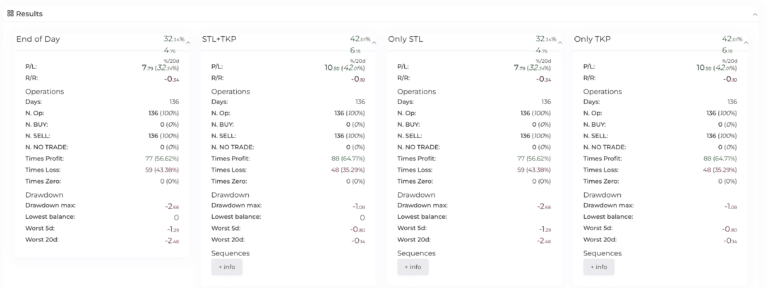
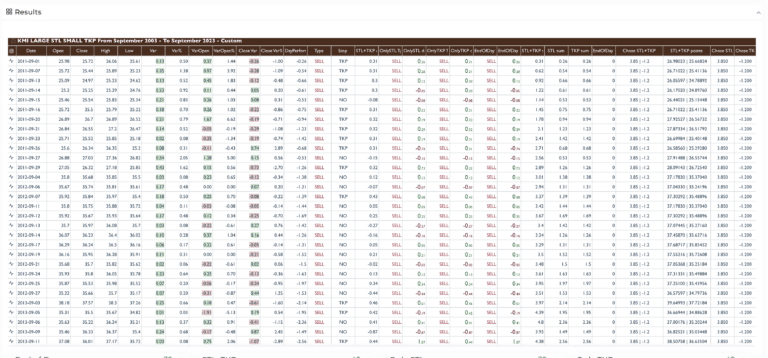
The Equity Line of the system
This chart shows the profit trend in the 4 modes, and the blue line represents the equity of the stock (not accounting for overnight gaps because the market is not open in this system). The histograms at the bottom represent the result of each individual operation in the 4 modes, in this case, RED because they are SELL operations.
We notice that if we had simply invested LONG in the stock over the same period (blue line), we would have performed almost as well as our system and in some cases better, leading us to conclude that the system is good but not better than the stock itself.

System Drawdown
The drawdown chart shows how much our investment in the system would have been exposed; we also notice here that using the Take Profit exposes you to less risk than not using it, confirming the peculiarity of this system that requires a tighter Take Profit than the Stop Loss. In any case, the maximum exposure reaches -2.7% when the Take Profit is not used, and approximately -1% when it is used.


Annual summary of the system
Here too, the data are shown according to the 4 trading modes. In the image, we see the best one is the use of Take Profit without Stop Loss, but even the one with Stop Loss performs practically the same. The results indicate that the system has been profitable every year since 2011, except for 2017 when it lost $0.52 (-2.67%).
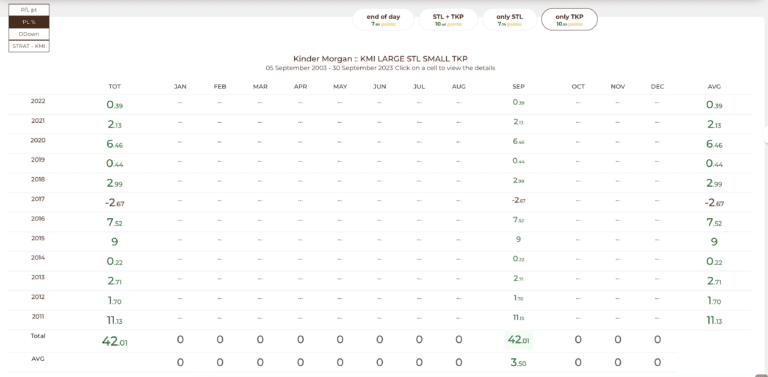
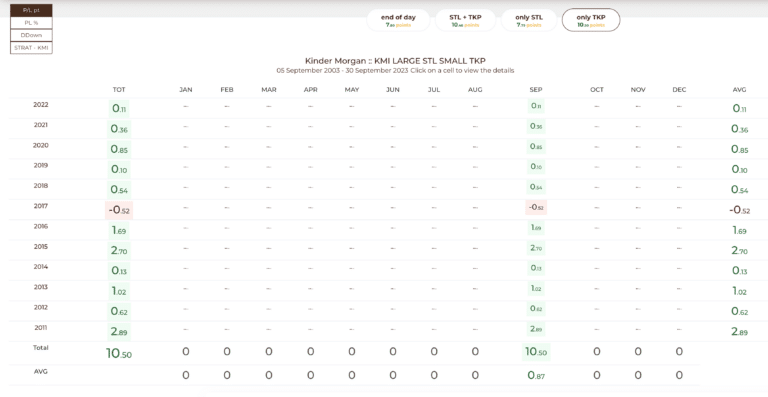
Dow is a company whose shares are valued between $30 and $50 each.
Global System Results
The system is based on one operation per day, to be opened at the market’s opening for the entire month of September when the session starts with a negative GAP. It also relies on a Risk/Reward (R/R) ratio of about 1.1, meaning you risk 1 to earn 1.1 on each operation. The Stop Loss is set at 1.95% from the opening, and the Take Profit is at -$2.20 from the opening.
The results show that the system performs better when applied using only the stop loss, yielding a 65.5% profit over the last 20 years with 97 wins and 64 losses. It’s worth noting that the count of wins and losses is close in each mode, suggesting that the stop loss provided some protection on unfavorable days, while the take profit capped earnings that could have been higher. Keep in mind that in this system it’s better to protect oneself and let the position run until the end of the day, according to historical performance.
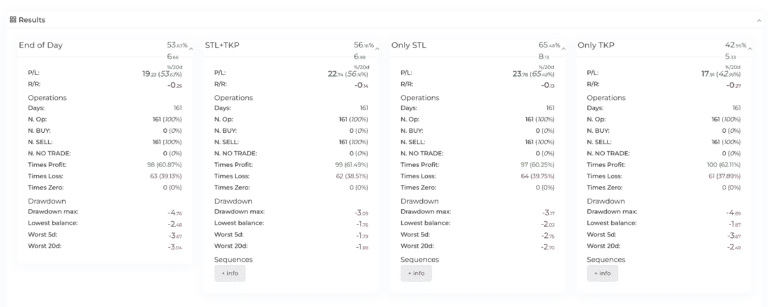
The Equity Line of the system
Here we notice that the system performs much better than the stock itself, which suggests that the system is an improvement. Moreover, our previous analysis is confirmed: the best mode is to execute trades with only stop loss and close at the end of the day.
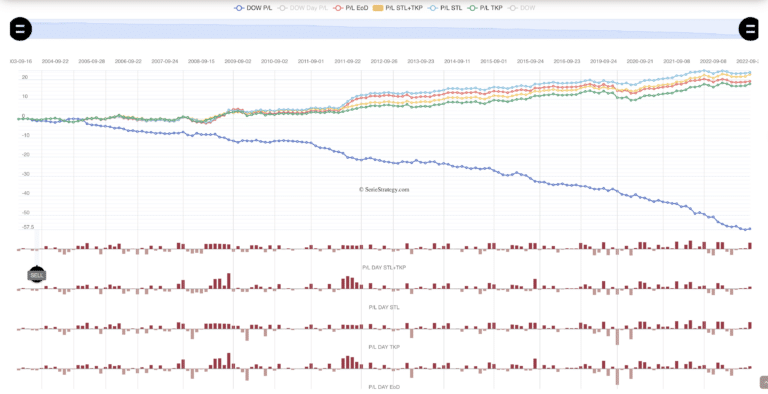
System Drawdown
From this analysis, we observe that the maximum exposure of our preferred choice, “stop loss only,” is less than when we do not protect ourselves. We go from -3% to -5% without protection.

Annual summary of the system
The summary is interesting because it shows that using only the stop loss results in higher gains over the total number of years, but at the same time, there is a slightly higher probability of encountering a losing year (3 times out of 16). However, if we also use the take profit, then there have been no losses from 2008 to the present. This information might lead us to change our approach and switch to a mode that includes both the stop loss and the take profit. This does not detract from the fact that the system is very interesting in all 4 modes.
Analyzing this system, it has been realized that it is very similar to the previous one and therefore the considerations made for the other system apply here as well. The only difference between the two systems is that in one case the stop loss is set at -1.9% and in this system at -1.95%, effectively making the two systems “close relatives.”
System Sizing
Before starting, we performed some calculations to understand the correct number of shares to sell each day based on the capital we decided to invest in each operation. Each share is worth about $50, and the capital we want to invest is a maximum of $10,000. My broker offers me a leverage of 1 to 4, I can operate up to $40,000. However, we like to maintain more than a 50% margin for position management, so we will only use 40% of it for the investment, which is $16,000. Dividing $16,000 by $50 per share, we get 320 shares to sell every day when the opening is negative throughout the month of September.
After analyzing the data, we decided to apply the trading system in September 2023. We have therefore chosen DOW – SELL when it Opens NEGATIVE – With a large Stop Loss and a tight Take Profit. As a method, we have chosen to apply both the stop loss and the take profit. Every day, just before the market opened, we monitored the pre-market price of DOW to gauge whether it would start off positive or negative. When it was negative, we set the bracket order at market and as soon as the stock exchange opened, we executed the order.
Here are the results for September 2023: 7 Trades (because it opened negative 7 times out of 20 trading days), of which 6 were won:

